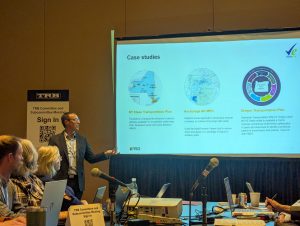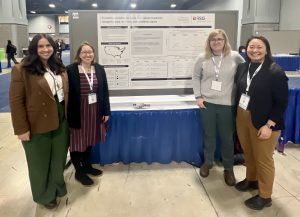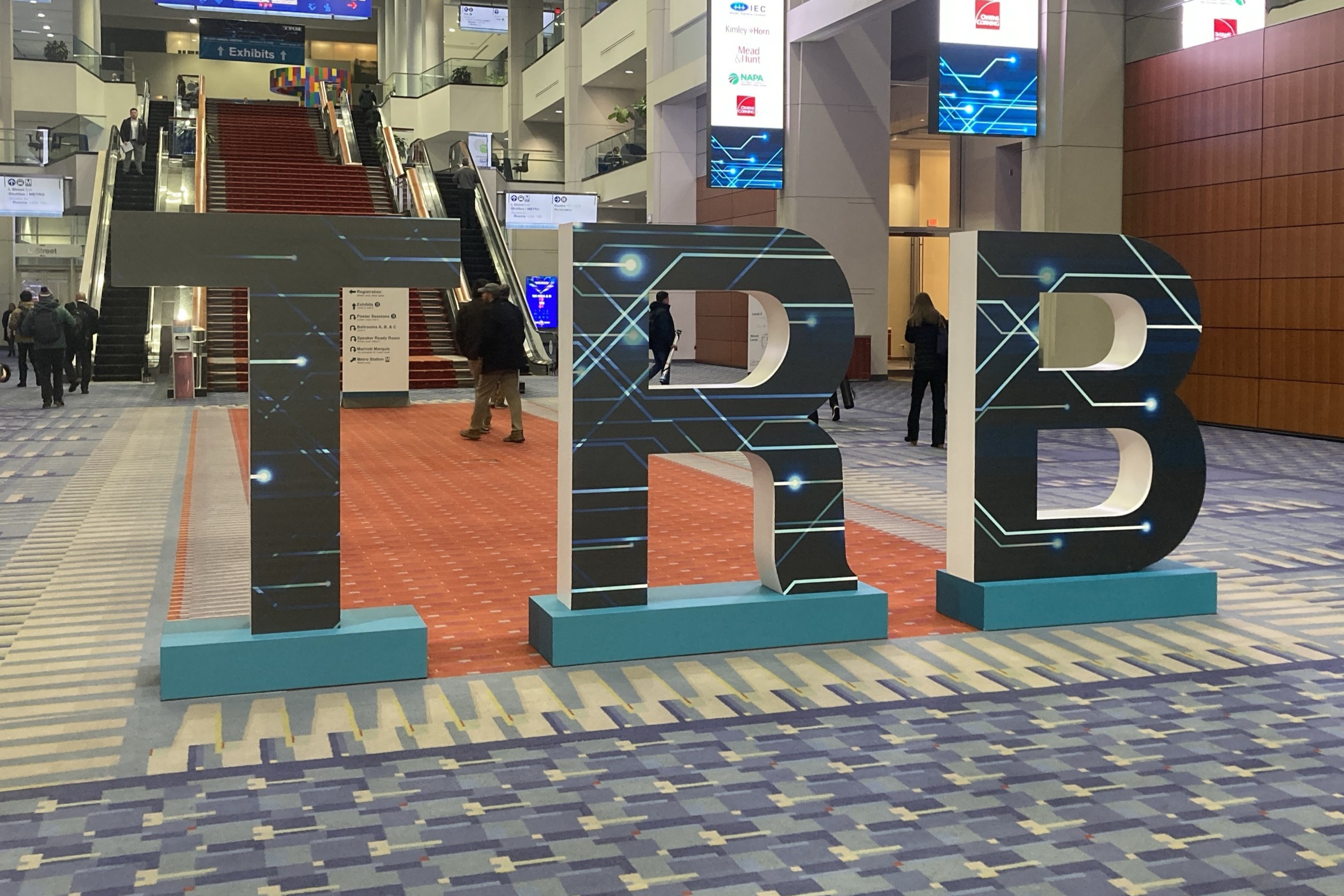Earlier this month, nearly two dozen RSGers traveled to Washington, DC, for the 104th Transportation Research Board (TRB) Annual Meeting. Our team shared eight posters during five sessions across three days, tackling topics ranging from big data to trends in household travel surveys. In addition to presenting, RSGers attended committee meetings and sat in on presentations, engaging with clients, colleagues, and collaborators to explore innovative approaches to today’s most pressing challenges. As we reflected on the discussions and themes that generated the most buzz at this year’s conference, three major topic areas stood out: putting safety at the forefront, quantifying the measures that matter, and understanding evolving travel behaviors.
We're Putting Safety at the Forefront
Safety was a recurring theme at this year’s Transportation Research Board Annual Meeting, and for good reason. Increased attention has been paid to road safety due to the decade-long rise in fatal crashes per mile traveled. Last year, the National Academies published a report on this alarming trend, noting that death rates in the United States from crashes are two to four times higher than those in other high-income countries.
Against this backdrop, RSG attendees at the Annual Meeting observed an increased emphasis on mitigating risks for vulnerable road users, or those outside of vehicles. Discussions highlighted that although progress has been made in infrastructure design (e.g., protected bike lanes and improved intersections), a crucial gap remains in understanding the individual choices and behaviors that lead to crashes. Current safety analyses, which often rely heavily on crash data, provide limited insight into these dynamics, focusing only on incidents after they occur. This reliance risks overlooking the actionable insights needed to prevent crashes in the first place.

Collecting data on how road users navigate and interact with their built environment can deliver additional insights to planners and practitioners to help move the needle on overall safety outcomes for vulnerable road users.
Bridging this gap calls for more comprehensive and innovative data collection methods to capture the nuanced, day-to-day experiences of vulnerable road users. Connected vehicle data being used in crash analysis does not include those outside of the vehicle. Traditional surveys and observational studies, while valuable, often miss the subtle route deviations or decision points that can illuminate higher-risk behaviors. Location-aware market research tools like rMove™ offer the ability to uncover these details, providing richer insights into how road users navigate and interact with their built environment. With this deeper clarity, agencies and practitioners can design safer, more inclusive travel networks that support all travelers, whether on foot, bike, or other modes.
We're Quantifying the Measures that Matter
Quantifying the measures that matter in transportation planning has become a central focus as agencies grapple to account for increasingly uncertain futures and shifting policy priorities. At this year’s Annual Meeting, a well-attended session delved into the challenges of planning amidst uncertainty, sparking conversations about how to better prepare for a range of potential outcomes.
Some practitioners are adopting strategic modeling tools like VisionEval to gain deeper insights into potential futures. Conventional approaches often present or “lock in” a single forecast, offering limited flexibility for exploring how changes in travel behavior, emerging technologies, or external shocks might reshape long-term needs. In contrast, tools such as VisionEval empower users to test multiple “What if?” scenarios, uncovering which policy or planning choices are most resilient and where adaptive strategies could deliver the most impact.
This scenario-based approach aligns with a growing emphasis on “co-benefits,” particularly as regions aim to reduce vehicle miles traveled (VMT) and greenhouse gas (GHG) emissions. Solely focusing on GHG reduction risks overlooking other immediate and tangible improvements of interest to stakeholders, such as enhanced air quality, health benefits from active transportation, increased safety, and improved travel options. By integrating these co-benefits into performance measures, planners can derive more relevant insights and better communicate the broader value reduced VMT or emissions deliver to communities.

RSG's Jonathan Slason presented on VisionEval and its use cases during the 2025 TRB Annual Meeting. Jonathan is a nationally recognized expert in helping clients apply VisionEval, an open-source strategic travel modeling tool designed to measure outcomes beyond the reach of traditional tools.
While open-source frameworks like VisionEval may not achieve the granularity of detailed travel models, they excel in testing multiple scenarios with speed and transparency. By varying inputs such as demographic shifts or policy interventions, planners can identify how different assumptions influence outcomes like congestion, mode share, and emissions. Focusing on measures that resonate with community goals—health, air quality, or greater access—enables decision-makers to simplify complex decisions and pursue investments that are resilient and future-focused.
We're Understanding Evolving Travel Behaviors
The pandemic’s lasting impact on work and daily routines has prompted a reassessment of how and why people travel. Once-regular weekday patterns have been disrupted by hybrid work schedules, making Monday-through-Friday travel anything but uniform. This irregularity has significant implications for transit agencies, roadway operators, and planners, highlighting the importance of data that offers both clarity on volumes and insight into shifting trip purposes by understanding travelers’ behaviors.
Among those conducting travel surveys, there is growing recognition that single-day surveys may miss nontraditional or infrequent travel patterns, such as employees who commute only on Tuesdays and Thursdays or parents managing staggered school schedules. Faced with lower response rates, agencies are exploring more engaging and flexible methods to capture the nuanced—and often complex—changes in travel behaviors.
When leveraging mobility data from third-party providers, some sessions emphasized that such information should complement, rather than replace, real-world data collection. While aggregate datasets provide valuable high-level insights into broad spatial trends, person- or household-level surveys remain critical for uncovering the deeper motivations behind travel decisions. By integrating these perspectives into a comprehensive mobility data analytics approach, practitioners can design more impactful data-collection efforts and validate broader trends with finer-grained insights.

RSGers presented several posters during Poster Session 3090, Travel Survey Experiences in the Post-Pandemic Era, which sought to help attendees better understand post-pandemic travel survey experiences.
Across the public and private sectors, there is a growing consensus that collaboration is essential. Pooling resources for survey design, sharing effective recruitment practices, and developing open-source tools to address evolving travel demands were all highlighted as promising strategies. Capturing and understanding how each segment of the traveling public is adapting allows planners to build transportation systems that are safe, responsive, and prepared for the continuing evolution of travel behavior.
Our Final Takeaways
As we reflect on this year’s TRB conference and look ahead to the next, the opportunity for our industry to create a meaningful and lasting impact on our communities has never been greater. Transportation researchers are harnessing AI and large language models to reveal deeper insights into travel behaviors and leveraging data to create safer streets, positioning the field for bold strides this year. Moreover, the pandemic’s lingering effects on behaviors continue to reshape foundational assumptions around commuting, mode choice, and network demand, uncovering numerous avenues for innovation and transformative solutions.
At the core of these shifts are research efforts and decisions aimed at building systems that are safer, efficient, and sustainable. Whether employing scenario-based models to better navigate uncertainty, designing real-time data collection methods that illuminate evolving travel patterns, or developing frameworks that emphasize co-benefits like health and safety, the challenges ahead offer us unique opportunities to deliver greater clarity and actionable insights for our clients and communities.
For newcomers and seasoned professionals alike, TRB’s annual meeting remains a vital platform to learn, connect, and collaborate. It’s a unique chance to share knowledge, advance innovation, and explore cutting-edge approaches to solving complex challenges. RSG looks forward to building on this year’s learning and progress, continuing to play a pivotal role for our clients in shaping transportation research, and carrying the momentum into 2025 and beyond.
····························
RSG attended the 104th Transportation Research Board (TRB) Annual Meeting in Washington, DC, from January 5 through January 9. Our presentations spanned topics from big data to household travel surveys, providing us with unique perspectives and valuable connections as we explored the latest trends and innovations in transportation research. Learn more about our presenters and their topics »


